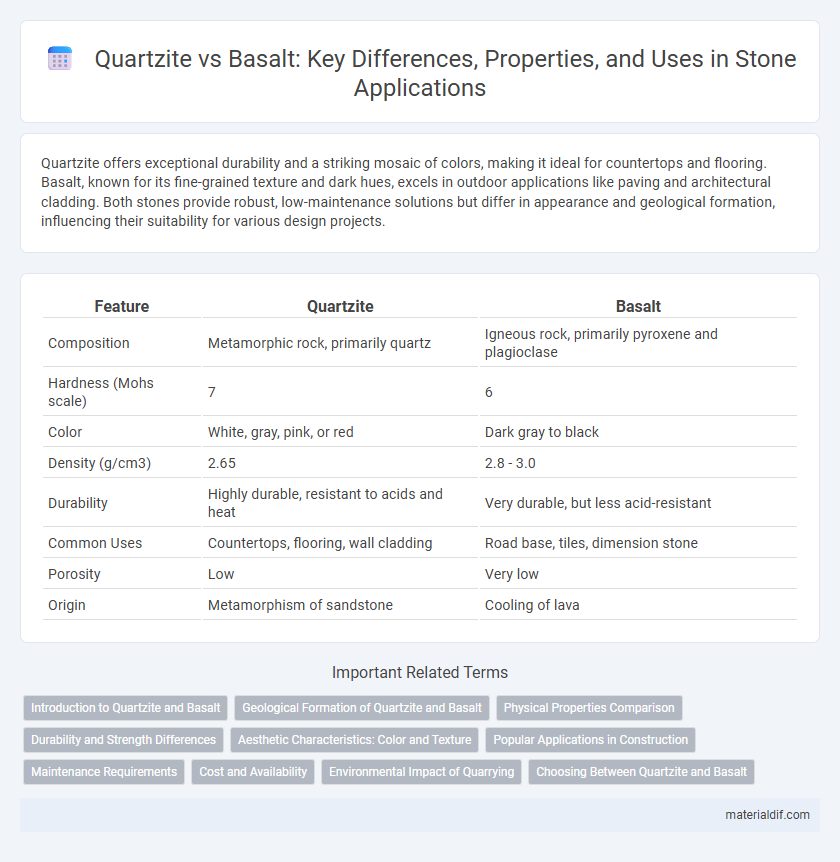Quartzite offers exceptional durability and a striking mosaic of colors, making it ideal for countertops and flooring. Basalt, known for its fine-grained texture and dark hues, excels in outdoor applications like paving and architectural cladding. Both stones provide robust, low-maintenance solutions but differ in appearance and geological formation, influencing their suitability for various design projects.
Table of Comparison
| Feature | Quartzite | Basalt |
|---|---|---|
| Composition | Metamorphic rock, primarily quartz | Igneous rock, primarily pyroxene and plagioclase |
| Hardness (Mohs scale) | 7 | 6 |
| Color | White, gray, pink, or red | Dark gray to black |
| Density (g/cm3) | 2.65 | 2.8 - 3.0 |
| Durability | Highly durable, resistant to acids and heat | Very durable, but less acid-resistant |
| Common Uses | Countertops, flooring, wall cladding | Road base, tiles, dimension stone |
| Porosity | Low | Very low |
| Origin | Metamorphism of sandstone | Cooling of lava |
Introduction to Quartzite and Basalt
Quartzite is a metamorphic rock formed from quartz-rich sandstone exposed to high heat and pressure, characterized by its hardness, resistance to weathering, and glassy luster. Basalt is an igneous rock originating from the rapid cooling of basaltic lava, notable for its fine-grained texture, dark color, and high density. Both stones are used extensively in construction and decorative applications due to their durability and distinct aesthetic qualities.
Geological Formation of Quartzite and Basalt
Quartzite forms through the metamorphism of sandstone under intense heat and pressure, causing quartz grains to recrystallize into a dense, hard rock with interlocking crystals. Basalt originates from the rapid cooling of low-viscosity lava at the Earth's surface, resulting in a fine-grained, mafic igneous rock rich in iron and magnesium minerals. Quartzite's formation occurs deep within the Earth's crust, while basalt is primarily extrusive and associated with volcanic activity.
Physical Properties Comparison
Quartzite exhibits high hardness, typically around 7 on the Mohs scale, making it extremely resistant to scratching and abrasion. Basalt has a lower hardness, approximately 6, but surpasses quartzite in density and compressive strength, often exceeding 200 MPa. Both stones have excellent durability, but quartzite's greater resistance to weathering contrasts with basalt's superior thermal conductivity and impact resistance.
Durability and Strength Differences
Quartzite exhibits exceptional durability and strength due to its natural formation from sandstone subjected to intense heat and pressure, resulting in a hard, dense stone with high resistance to abrasion and weathering. Basalt, an igneous rock formed from cooled lava, also offers impressive strength and durability, characterized by its fine-grained texture and high compressive strength, making it suitable for heavy-duty applications. While both stones provide significant structural integrity, quartzite generally surpasses basalt in resistance to scratches and chemical erosion, whereas basalt excels in impact resistance and thermal stability.
Aesthetic Characteristics: Color and Texture
Quartzite exhibits a broad spectrum of colors ranging from white, gray, and pink to red and blue, characterized by a glassy, granular texture that reflects light for a shimmering effect. Basalt typically presents a dark gray to black coloration with a fine-grained, dense texture that offers a matte or slightly rough surface appearance. The vivid, translucent quality of quartzite contrasts with the uniform, volcanic solidity of basalt, influencing design choices based on desired visual impact and tactile experience.
Popular Applications in Construction
Quartzite is widely used in construction for countertops, flooring, and wall cladding due to its durability and resistance to heat and scratches. Basalt, valued for its high compressive strength and weather resistance, is commonly employed in road base materials, building facades, and as aggregate for concrete. Both stones offer distinct advantages, with quartzite favored for aesthetic interior applications and basalt preferred for structural and infrastructure projects.
Maintenance Requirements
Quartzite requires minimal maintenance due to its high durability and resistance to scratches and stains, making it ideal for countertops and flooring. Basalt, while also durable, may need periodic sealing to prevent moisture absorption and maintain its appearance, especially in outdoor or high-traffic applications. Both stones benefit from regular cleaning with pH-neutral detergents to preserve their natural beauty and structural integrity.
Cost and Availability
Quartzite generally commands a higher price point than basalt due to its natural rarity and complex extraction process. Basalt, abundant and widely available as a volcanic rock, tends to be more cost-effective for large-scale construction projects. Both stones offer durability, but quartzite's premium cost limits its accessibility compared to the economically viable basalt.
Environmental Impact of Quarrying
Quartzite quarrying generates less dust and noise pollution compared to basalt extraction, resulting in a lower impact on surrounding ecosystems. Basalt quarrying often involves more energy-intensive drilling and blasting, contributing to higher carbon emissions and habitat disruption. Sustainable practices in quartzite mining can reduce water consumption and soil erosion, making it more environmentally friendly than traditional basalt quarry operations.
Choosing Between Quartzite and Basalt
Quartzite offers exceptional hardness and resistance to abrasion, making it ideal for countertops and flooring in high-traffic areas, while basalt provides superior durability and thermal stability, suitable for outdoor applications such as paving and landscaping. The choice between quartzite and basalt depends on project requirements, with quartzite favored for its aesthetic appeal and slight translucency, and basalt chosen for its dense, dark appearance and slip resistance. Consider factors like environmental exposure, maintenance needs, and design preferences to determine the best stone for your use case.
Quartzite vs Basalt Infographic

 materialdif.com
materialdif.com